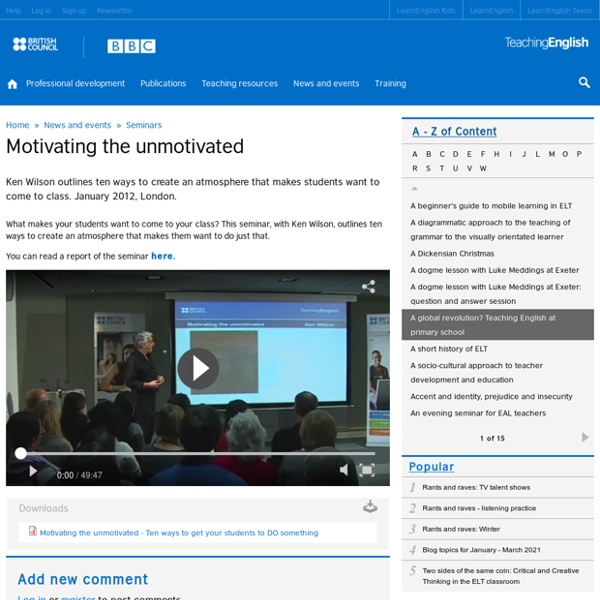



https://www.teachingenglish.org.uk/article/motivating-unmotivated
Related: TEACHING YL ONLINE • How to plan a great lesson • all • How to plan a lesson • Lessons and teachingGetting teenagers to talk Keep the conversation peer centred: plenty of pair or small group collaboration.Avoid asking discussion questions around the class: this puts them in the spotlight and causes potential embarrassment in front of friends. You also risk dominating the talk.Give them a concrete list of statements or opinions: help them to choose their own ideas. Don’t expect them to have fully formed opinions on all things teenage! Motivating teenagers I will link three practical classroom activities to the ideas of American Psychologist Carl Rogers. The ideas of Carl Rogers Types of motivation and teenagers Ways to improve motivation:Journals - empathy Using photos - authenticity Music - acceptance The ideas of Carl Rogers Rogers (1957) outlined 3 attitudinal qualities that a teacher, or in his words, a facilitator, should have to assist the learning process. They are empathy (seeing things from the students' viewpoint), authenticity (being yourself) and acceptance (of students' ideas and opinions). Types of motivation and teenagers It is widely agreed that motivation has a great effect on a student's capacity to learn. Motivation can be broken down into extrinsic and intrinsic forms.
Writing and young learners Writing and Young Learners Writing can be an engaging, interesting and inspiring activity for young learners. Children are active learners and thinkers (Piaget 1965), learn through social interaction (Vygotsky 1978) and learn effectively through scaffolding by more able others (Maybin et al 1992), who can be adults or peers. Collaborative and well-planned writing tasks encourage the context for all of these characteristics to be fully exploited in the young learner classroom. Motivating speaking activities At this age, the learners aren't motivated by new language, they're motivated by an activity. It can be very difficult to get them to speak if they really don't see the point. You can approach this by focussing on the following. The function of the language and using an authentic or near authentic task (e.g. get them to sit back-to-back to practise speaking on the telephone).A motivating task, which uses the language you want them to practise (e.g. students write questions on small squares of paper using the target language, then form the papers into a board game to be played using dice and counters). Here are some possible examples, which apply to one or a combination of the above. A popular, well-known type of activity is the information gap.
Motivating speaking activities for lower levels Planning time has been shown to increase production in speaking tasks. Lower level learners often find it especially difficult to speak spontaneously, so these activities incorporate 'thinking time' during which learners can prepare for speaking by planning what they are going to say, and asking the teacher or using a dictionary to look up missing vocabulary. The following activities are relatively short, with minimal materials preparation time for the teacher. They are designed for use as a warmer or a filler in the middle or at the end of a class. 1. Definitions lists L1 Skip to content L1 is a speaker's first language. L2 is the second, L3 the third etc. ExampleA learner whose L1 is Spanish may find Portuguese and Italian easy languages to learn because of a fairly close connection between the languages.
Motivating pupils to read This article describes ways to generate initial motivation, the second one shows how to maintain this motivation. Motivation Creating the basic motivational conditions Generating initial motivation References Motivation Motivation is one of the key factors that determine the rate and success of L2 attainment. It provides the main incentive to initiate learning a foreign language and later the determination to persevere and sustain the long and often difficult learning process. Without sufficient motivation, even individuals with the best of abilities cannot accomplish long-term goals.
IATEFL 2018: Safe Speaking Environments - What? Why? How? Published 9 April 2018 In our first post from IATEFL 2018, we’re sharing the talk from Professor of Psycholinguistics, Zoltán Dörnyei, on what exactly Safe Speaking Environments are and why you should care. The talk looks at creating a psychological environment in the classroom which might make students’ lives easier. Zoltán says that in order to facilitate speaking in the language classroom, we need to: TeachingEnglish Skip to content You are here Home » Professional development » Teachers
Bradley - Scaffolding Academic Learning for Second Language Learners The Internet TESL Journal Karen Sue Bradley & Jack Alden Bradleykfksb00 [at] tamuk.eduTexas A&M University (Kingsville, Texas, USA) Introduction What is meant by the term scaffolding? "Scaffolding refers to providing contextual supports for meaning through the use of simplified language, teacher modeling, visuals and graphics, cooperative learning and hands-on learning" (Ovando, Collier, & Combs, 2003, p. 345).
BusyTeacher.org Writing a lesson plan will ensure that you are prepared for your class and will make it run more smoothly. It is important to break the material up into several sections and choose activities suitable for each. Knowing approximately how much time an activity will take is important, but after the first lesson you may need to adjust things accordingly. It is best to be flexible seeing as different classes will respond to material differently. If at any point students struggle, you will have to dedicate more time to instruction or drilling before moving on to practice activities.